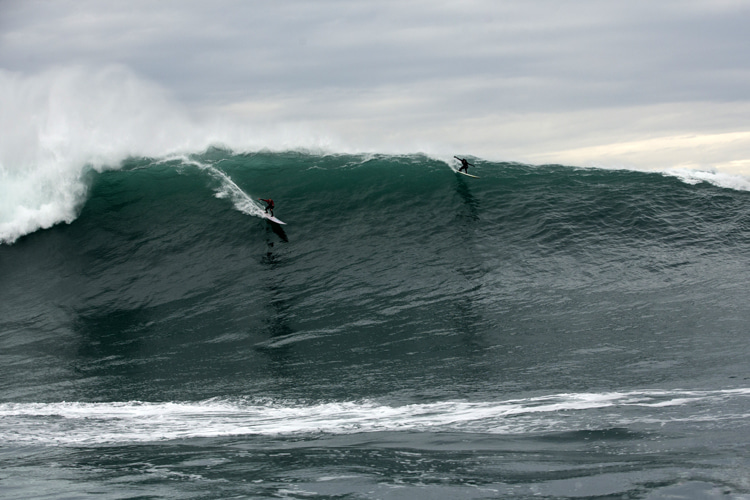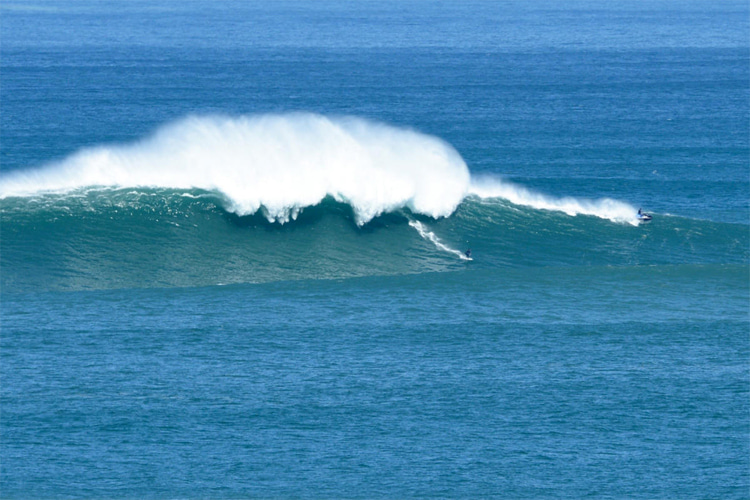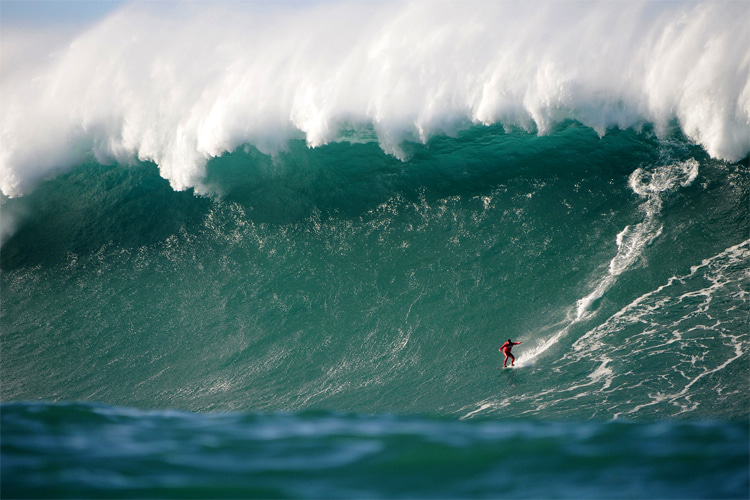France is home to world-class surf breaks, including a couple of big wave spots. Meet Belharra, the country's liquid avalanche.
Slowly but steadily, Europe has brought its Atlantic extreme arenas to the surface. Some of them have been unexplored for decades.
Or even hidden from the public's eye and kept secret just for a handful of local veteran surfers. That was the case of Nazaré, Mullaghmore Head, Jardim do Mar, Aileen's, and Punta Galea.
Belharra is another excellent example of the Old Continent's natural resources when it comes to producing XXL water mountains.
The French reef break is located 2.5 kilometers northwest off the coast of the fishing town of Saint-Jean-de-Luz in the Northern Basque Country.

The Offshore Seagrass-Covered Shoal
The 15-meter deep, seagrass-covered shoal offshore spot creates a gigantic A-frame peak on the two or three largest swells of the winter.
It's one of the go-to take-off peaks for the European tow-in crew.
The wave has been surfed since at least the early 1990s.
Nevertheless, a small team made history on November 2, 2002, before a second session on March 10, 2003, when Sebastian St. Jean towed into a wave estimated at 66 feet (20 meters), winning the XXL contest final.
The name of the wave refers to the steep submarine rock that allows it to be formed in some specific swell and wind conditions.
In Basque, "Belarra" means grass or weed.
The spot is relatively inaccessible and requires excellent physical conditions to be tamed.
Even an advanced-level surfer might not have what it takes to take on Belharra, a spot that is also known as Belharra Perdun.
After observing the local weather conditions, only professionals, supervised by a competent and trained jet ski and safety team, can consider going to Belharra.
The underwater reef features a plateau with a projected step-like structure that produces a massive and violent wave.
On special occasions, the swell was so powerful that it swallowed the boats moored nearby at Socoa before the jetty was built.
Some say it only breaks a few times per decade, but when it does, Belharra produces a massive and violent wave with a heavy lip.
Anatomically speaking, Belharra is a different wave from the ones we're used to seeing exploding, for instance, at Jaws/Peahi.
It features an oblique profile, and although it does not present surfers with the steepest drop, it can get tricky to tame.
Some surfers opt for gun surfboards when Belharra is pumping under 30-foot waves (10 meters). However, on bigger sessions, tow-in boards are required.

A Rare Gem
Belharra roars to life with a powerful North Atlantic west groundswell boosted by an eastern offshore wind.
The wave only breaks on low tide unless it is absolutely huge and out of control. It usually forms during the autumn and winter off the Basque coast.
The French big wave spot is never too crowded, even during epic sessions. Unfortunately, its outer reef characteristics also mean there will be a lack of help nearby if anything goes wrong.
The best way to get to the infamous break is by getting on a boat or jet ski in the southwest of the bay of Saint-Jean-de-Luz.
The French wave that lies offshore in the department of Pyrénées-Atlantiques is highly sensitive to swell and wind angles.
The French monster needs special conditions to shine in all its glory, but surfers from all over the world meet in the water to face this French sea monster.
Axi Muniain, Alain Riou, Benjamin Sanchis, Eric Rebiere, Eric Rougé, Jamie Mitchell, Jamie Mitchell, Julian Reichman, Justine Dupont, Max Larretche, Peyo Lizarazu, Pierre Rollet, Pilou Ducalme, Stéphane Iralour, and Yann Benetrix are some of the surfers who take on Belharra on a regular basis.
It is famously known for providing primarily left-hand waves, but Belharra also produces quality right-hand gems.
Although the full drop can be long, the French oceanic avalanche can get surfers riding down the face at high speed.
It's a different wave, delivering different experiences and making it one of Europe's most noble liquid princesses.
In 2013, Gautier Garanx won the XXL Biggest Wave of the Year award for a massive wall of saltwater ridden at Belharra.
In early 2014, Jamie Mitchell wiped out and took a beating after getting into one of the largest paddle-in waves ever at this spot.
Watching the French Avalanche
Spectators can watch the XXL sessions from the coast road cliffs between Socoa and Hendaye.
The place is definitely a spectator-friendly activity, and if you're equipped with telephoto lenses and binoculars, you can easily follow all the action.
To be more precise, the best place to see the Belharra wave is from the Basque Corniche, Urrugne's natural promontory.
You may also try the esplanade in front of the Juancho campsite.
This is the place where everyone comes together. This esplanade of rocks dominates the ocean and offers a perfect view of Belharra.
But there's more.
The Corniche World War II blockhouse is perfect for seeing the wave in the distance. There's even parking nearby.
Finally, at the Egiategia vineyard, it is possible to gain a little height by taking the road to the waste disposal center from the Basque Corniche.
